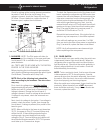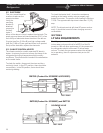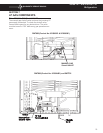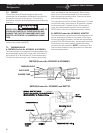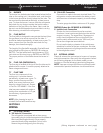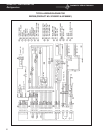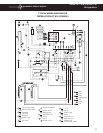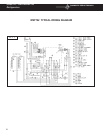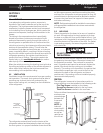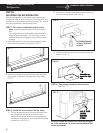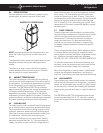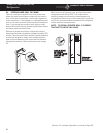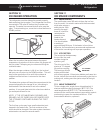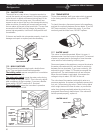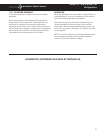
25
DIAGNOSTIC SERVICE MANUAL
DOMETIC® RM7030/RM7732
Refrigerators
SECTION 9
OTHER
9.1 LEVELING
In an absorption refrigerator system, ammonia is
liquefied in the finned condenser coil at the top of the
refrigerator. The liquid ammonia then flows into the
evaporator (inside the freezer section) and is exposed
to a circulating flow of hydrogen gas, which causes the
ammonia to evaporate, creating a cold condition in the
freezer.
The tubing in the evaporator section is specifically
sloped to provide a continuous movement of liquid
ammonia downward by gravity through this section. If
the refrigerator is operated when it is not level and the
vehicle is not moving, liquid ammonia will accumulate in
sections of the evaporator tubing. This will slow the
circulation of hydrogen and ammonia gas, or in severe
cases, completely block it, resulting in a loss of cooling.
Any time the vehicle is parked for several hours with the
refrigerator operating, the vehicle should be level to
prevent this loss of cooling. The vehicle needs to be
leveled only so it is comfortable to live in (no notice-
able sloping of floors or walls).
When the vehicle is moving, the leveling is not critical as
the rolling and pitching motion of the vehicle will pass to
either side of level, keeping the liquid ammonia from
accumulating in the evaporator tubing.
9.2 VENTILATION
Ventilation is one of the requirements for proper cooling
unit operation. The coach vent system must be able to
provide a way to direct the hot air produced by the
action of the cooling unit, out away from the installation
of the refrigerator.
The refrigerator extracts heat from the interior of the
refrigerator cabinet and dissipates the heat out through
the vent system. In a proper installation there should be
as little open space as possible surrounding the sides
and top of the refrigerator to achieve proper air flow. All
potential dead air pockets should be blocked or baffled
to ensure that heat won't be trapped in these spaces
and reduce efficiency.
NOTE: Refrigerators should be installed in accordance
with appropriate installation instructions received with
the refrigerator.
9.3 AIR LEAKS
Check the gasket on the doors to be sure of a positive
air seal. A simple method to check gaskets is to close
the door on a dollar bill, then pull the dollar bill out. If no
resistance is felt, the gasket is not sealing properly. This
should be done on all four sides of the door. If a gasket
is not sealing properly, first warm the gasket material
with a hair drier.
DO NOT OVERHEAT AS YOU CAN MELT
THE MATERIAL.
Then close the door and the magnetic strip should pull
the gasket to the metal frame. Leave door closed until
the material has cooled. Then recheck for a positive
seal. If a positive seal cannot be achieved, replace the
gasket. Also check that the cooling unit is installed
properly. The cooling unit's foam block, the portion that
surrounds the evaporator coils, must be flush to the
cabinet at the back of the refrigerator and have a
positive seal. If the cooling unit is not installed properly,
remove and install properly.
RM7030:
The refrigerator is secured in the enclosure with six
screws and they must be installed in the following order:
First Two Screws installed on front base;
Second Two Screws installed in the top frame;
Third Two Screws installed in the rear base.
Failure to follow the sequence in securing refrigerator in
enclosure can
cause leakage
between the
frame and
cabinet.
NOTE: Air
leaks will
cause insuffi-
cient cooling
as well as
rapid forma-
tion of frost.
0" CLEARANCE
FROM SIDE OF
CABINET
PATH OF
AIR FLOW
CLEARANCE
FROM
COMBUSTIBLE
MATERIALS
2ND
1ST
3RD



